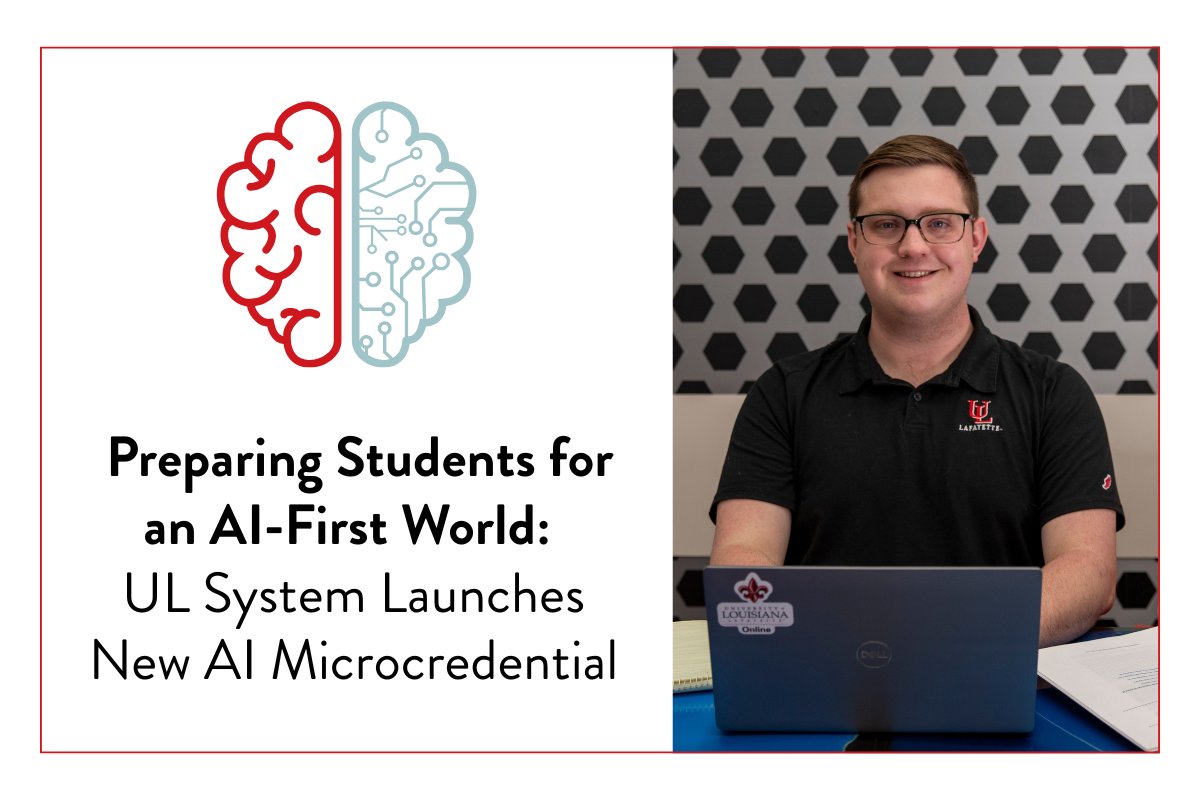Since the launch of ChatGPT in 2022 and the subsequent boom of generative AI, major U.S. employers, including Shopify, Duolingo, and Google, have announced their adoption of AI-first business models.
To prepare students for this shift, Dr. Colleen Carraher Wolverton, professor in the University of Louisiana at Lafayette B.I. Moody III College of Business Administration, created a new course, MGMT 455: AI & Emerging Tech in Business.
As she developed the course, she couldn’t find high-quality educational resources on AI literacy.
“There really are no textbooks that cover this in the way that I’m looking for,” she says.
The Empowering AI Literacy for Students microcredential, developed by faculty and staff across the University of Louisiana System and available for free to all enrolled students, is now filling that gap.
Supplementing Her Course
When generative AI emerged, Wolverton, who studies IT adoption and holds a Ph.D. in Information Systems, quickly identified it as a tool to watch.
The challenge, however, was finding educational materials on AI to share with her students.
“Most of the materials out there right now about AI are highly technical and involve creating your own AI tool of some sort,” she explains. “My goal, however, is to talk about how to use AI, not develop it. If you’re the CEO of an organization, for example, how are you going to use AI in your day-to-day work?”
With nowhere else to turn, Wolverton began developing her own materials. When the AI literacy microcredential became available in Spring 2025, Wolverton knew it would be a great supplement to her course.
“It’s probably the closest that I’ve been able to get to having resources to give my students a baseline understanding of AI,” she says. “Plus, it’s exclusive to the UL System, which my students love.”
Dr. Katie Dawson, associate vice president of enrollment, innovation, and talent strategy for the UL System, played a key role in coordinating the AI microcredential’s development. Dawson says the AI microcredential provides another distinction for students to pursue as they prepare for the careers ahead of them.
“Microcredentials are a powerful way to recognize and validate learning that complements a student’s degree,” she says. “They highlight in-demand skills, such as project management, data analytics, or AI literacy, giving students credentials that align with workforce needs.”
Making Her Course Flow
So far, Wolverton has offered students the opportunity to complete the AI literacy microcredential for extra credit. As she refines the course, she’s exploring ways to integrate it completely.
“One thing I’ve considered doing is breaking it up so that students are assigned to complete the modules for the microcredential as they go through my course,” she explains.
Those modules span a range of competencies related to AI literacy, starting with a historical overview of what AI is and how it works, followed by tips, best practices, and ethical considerations.
Much of the microcredential’s content aligns seamlessly with Wolverton’s course assignments. In one assignment, for example, Wolverton asks her students to use AI to help them write an email in a fictional scenario, using what they know about AI to generate a workable output.
“I’ll have them take screenshots of their conversations with AI, and I’ll read through those conversations and give feedback on how well they prompted the AI tool,” she explains.
Understanding the Drawbacks
Despite AI’s potential, Wolverton remains acutely aware of the challenges related to AI use and of the need for limitations.
“One of the things we see, for example, is companies using AI to review resumes and make hiring decisions,” she says. “However, if the AI tool isn’t trained well, companies may end up rejecting people who would be good for the job or show bias in their hiring decisions.”
Thus, Wolverton maintains a strict policy on AI: students may use it as a tool or resource, but using it blindly or in situations where its use is explicitly prohibited is unacceptable.
“When somebody just copies and pastes something straight from AI, whether that’s for a class assignment or for a project at work, it’s disappointing,” she asserts. “It shows how little energy they gave toward completing the task.”
In her view, maintaining course policies on AI is one of many ways to instill AI literacy in students.
“What I fear is that students will use it improperly at work and get in way bigger trouble than they would for using it in my class,” Wolverton says. “There were some attorneys years ago who used ChatGPT to write some of their legal documents and ended up referencing case law that didn’t exist. In a situation like that, you could be sanctioned or potentially disbarred.”
Through her course and the AI literacy microcredential, Wolverton hopes to teach students how to effectively use their skills in tandem with AI, achieving more than they would be able to on their own.
“I’m often surprised at how many students don’t use AI because they’re afraid to,” she reflects. “I had a student last semester who was asked by his boss at his internship to use ChatGPT for certain tasks and had just used AI for the first time in my class.”
“So many people are looking at the potential for AI to take our jobs. I view it as more that it’s going to assist you. It can give you a good start, but ultimately, the final product depends on your human expertise and unique skills.”
Integrate AI literacy into your course with the UL System’s Empowering AI Literacy for Students microcredential. Contact distancelearning@louisiana.edu to learn more.
